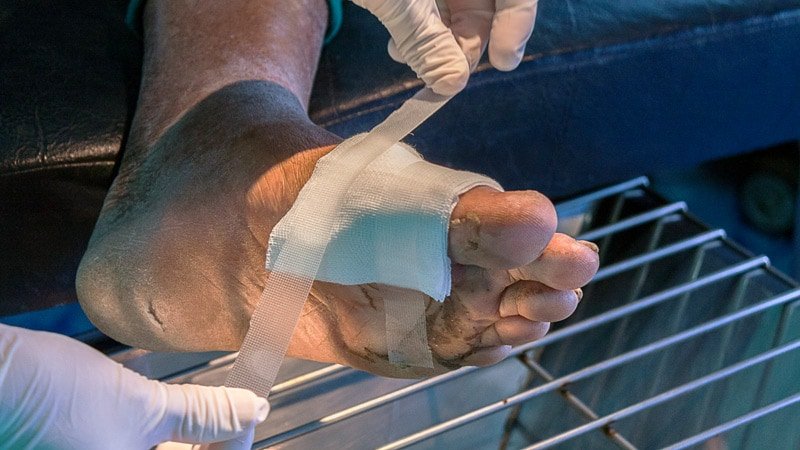Editor’s note: Find the latest COVID-19 news and guidance in Medscape’s Coronavirus Resource Center.
The COVID-19 pandemic was not associated with increased limb loss among people with diabetes in Ontario, Canada, new research suggests.
The findings, which contrast with those from several other locales worldwide, were published online January 5 in JAMA Network Open by Charles de Mestral, MDCM, PhD, of the Li Ka Shing Knowledge Institute of St. Michael’s Hospital, Toronto, Ontario, and colleagues.
Despite limited in-person visits with physicians, hospital avoidance, and non-emergency surgical procedure restrictions, excess leg amputations were not seen among people with diabetes during the first 11 months of the COVID-19 pandemic. The authors postulate several reasons for this, including prioritization of foot care.
“Diabetes and foot care clinics need to maintain contact with their patients and continue providing foot screening as best (as) possible through virtual care coupled with in-person visits when necessary,” de Mestral told Medscape Medical News.
Moreover, he added, “hospital and healthcare systems need to maintain access to limb-preserving interventions such as lower extremity revascularization for those with a diabetic foot complication.”
And people with diabetes should be advised to check their feet daily and wear protective footwear both in and outside their homes, de Mestral added.
Major Amputations Didn’t Rise During Pandemic.
The population-based study compared foot care-related practices and outcomes for 1,488,605 adult residents of Ontario with diabetes during January 2020-February 2021 with those of 1,441,029 during January 2019-February 2020. Age and demographic characteristics were similar between the two groups.
Major amputations during the pandemic period never exceeded those of the prior year and actually decreased twice. The rate ratio for the pre-pandemic period of January 1-March 10, 2020 was 1.05, and during the pandemic ranged from 0.86 in May 20-July 28, 2020 to 0.95 during October 7-December 15, 2020. None of those values were significant.
Rates of comprehensive in-person diabetes care assessment dropped significantly in March 11-May 19, 2020, by 28% compared to 2019, and remained low over the study period.
A1c measurement also declined, initially to 41% of the 2019 level, but then increased significantly to 84% between the first and second COVID-19 waves.
Emergency department visits and hospitalizations for diabetic foot ulceration, osteomyelitis, or gangrene dropped significantly early during the pandemic but recovered to 2019 levels during July 29-October 6, 2020.
Similarly, rates of lower extremity revascularization and minor amputations declined initially — with a rate ratio of 0.66 during March 11-May 19, 2020 for open revascularization and 0.70 for both endovascular revascularization and minor amputation, all significant — but then rebounded.
Did COVID-19 Deaths Reduce the Amputation Rate?
Cumulative incidences of major amputation and death without major amputation in the pandemic-era cohort were 0.08% and 3.07%, respectively, compared with 0.09% and 2.77%, respectively, in 2019. Although this suggests that excess pandemic-related deaths may have reduced total amputations, other findings argue against that, the authors say.
For one, the proportion of people living in long-term care settings, in whom approximately 80% of COVID-19–related first-wave deaths occurred, was not lower among individuals undergoing amputation in the 2020-2021 period compared with those in the 2019-2020 period. Moreover, the comorbidity level among individuals undergoing amputation in 2020-2021 relative to the 2019-2020 control groups was not consistently lower with the onset of the pandemic.
“Thus, the demographic and comorbidity profiles of individuals undergoing amputation during the pandemic, when compared with the 2019-2020 control groups, do not suggest that older adults with limb-threatening complications died during the pandemic rather than underwent amputation. Nevertheless, at an individual level, it remains possible that some deaths during the pandemic occurred in patients who might otherwise have undergone amputation. More granular data on the foot health of decedents with diabetes during the pandemic are necessary to further clarify this issue,” de Mestral and colleagues write.
Why Was Ontario Different?
These results contrast with those of several other reports of increases in amputations during the pandemic — some dramatically — among patients with diabetic foot ulcers from around the globe, including in China, the United States, the Netherlands, India, and Italy.
One possible explanation for the different results in Ontario, de Mestral and colleagues hypothesize, was that hospitals in the Canadian province were not as overburdened with COVID-19 patients during the first wave of the pandemic so hospital restrictions were relatively brief, about 10 weeks, and weren’t reinstated.
Moreover, Ontario hospitals prioritized invasive procedures needed to treat limb-threatening diabetes complications, such as toe or partial-foot amputations and revascularization, even early during the pandemic. “The importance of maintaining capacity to evaluate urgent ambulatory presentations in person was widely recognized, including by wound care and surgical specialists,” the authors note.
Another possibility is that lockdowns during the first and second pandemic waves may have led to a relative reduction in daily activities, which could have reduced the risk for repetitive microtrauma to the feet and toes, and therefore lowered the risk for ulceration in those with neuropathy. “This hypothesis supports the value of proper footwear and offloading of pressure points,” they say.
Overall, de Mestral and colleagues conclude that although the COVID-19 pandemic did not appear to be associated with additional limb loss for people with diabetes, “as we emerge from the pandemic, ongoing efforts to strengthen comprehensive diabetes care, including foot screening as well as improving access to interdisciplinary limb salvage expertise, remain critical to maintain these positive results.”
The study was directly supported by the Ontario Health Data Platform, the Research Innovation Council of the St. Michael’s Hospital Foundation, and a Canadian Institutes of Health Research foundation grant. The authors had no further disclosures.
JAMA Netw Open. Published online January 5, 2022. Full text
Miriam E. Tucker is a freelance journalist based in the Washington, DC, area. She is a regular contributor to Medscape, with other work appearing in The Washington Post, NPR’s Shots blog, and Diabetes Forecast magazine. She is on Twitter: @MiriamETucker.
For more diabetes and endocrinology news, follow us on Twitter and Facebook.
Source: Read Full Article
